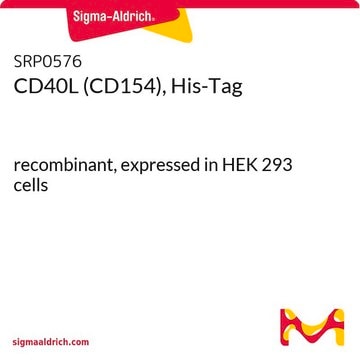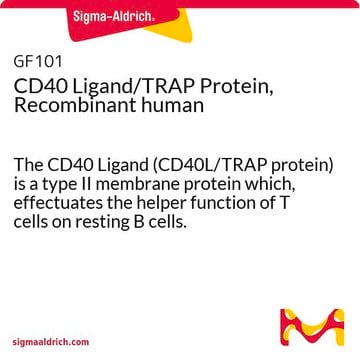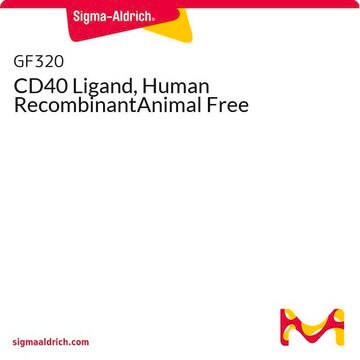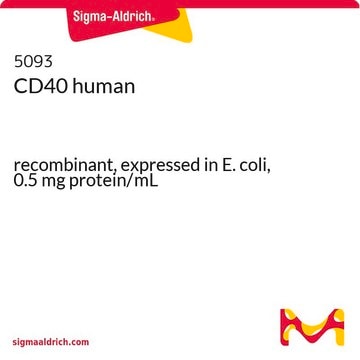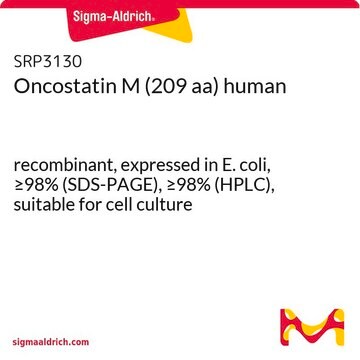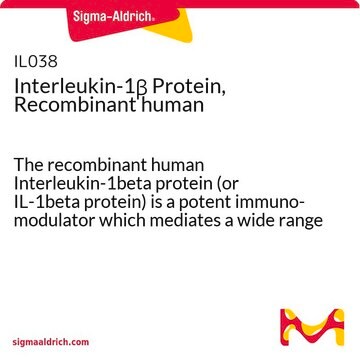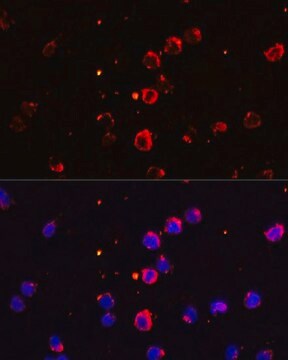SRP3306
SCD40 LIGAND
Animal-component free, recombinant, expressed in E. coli, ≥98% (SDS-PAGE), ≥98% (HPLC)
Sinónimos:
CD154, TNFSF5, TRAP, gp39
Iniciar sesiónpara Ver la Fijación de precios por contrato y de la organización
About This Item
Código UNSPSC:
12352200
NACRES:
NA.77
Productos recomendados
origen biológico
human
recombinante
expressed in E. coli
Análisis
≥98% (HPLC)
≥98% (SDS-PAGE)
formulario
lyophilized
potencia
5-10 ng/mL ED50
mol peso
16.3 kDa
envase
pkg of 50 μg
impurezas
endotoxin, tested
Nº de acceso UniProt
Condiciones de envío
wet ice
temp. de almacenamiento
−20°C
Información sobre el gen
human ... TNFSF5(959)
Descripción general
CD40, a member of the TNF receptor superfamily, is a cell surface protein expressed on B cells, dendritic cells, monocytes, thymic epithelial cells and, at low levels, on T cells. Signaling though CD40 plays an important role in the proliferation and differentiation of B cells, and is critical for immunoglobulin (Ig) class switching. The membrane-anchored CD40-Ligand is expressed almost exclusively on activated CD4+ T lymphocytes. Failure to express CD40L leads to “immunodeficiency with hyper-IgM”, a disease characterized by failure to produce IgG, IgA and IgE. The human CD40L gene codes for a 261 amino acid type II transmembrane protein, which contains a 22 amino acid cytoplasmic domain, a 24 amino acid transmembrane domain, and a 215 amino acid extracellular domain. The soluble form of CD40L is an 18 kDa protein comprising the entire TNF homologous region of CD40L and is generated in vivo by an intracellular proteolytic processing of the full length CD40L. Recombinant human soluble CD40 ligand is a 16.3 kDa protein containing 149 amino acid residues comprising the receptor binding TNF-like domain of CD40L.
Acciones bioquímicas o fisiológicas
CD40, a member of the TNF receptor superfamily, is a cell surface protein expressed on B cells, dendritic cells, monocytes, thymic epithelial cells and, at low levels, on T cells. The soluble form of CD40L is an 18 kDa protein comprising the entire TNF homologous region of CD40L and is generated in vivo by an intracellular proteolytic processing of the full length CD40L. Recombinant human soluble CD40 ligand is a 16.3 kDa protein containing 149 amino acid residues comprising the receptor binding TNF-like domain of CD40L.
Forma física
Lyophilized from 10mM Sodium Phosphate, pH 7.5.
Reconstitución
Centrifuge the vial prior to opening. Reconstitute in water to a concentration of 0.1-1.0 mg/ml. Do not vortex. This solution can be stored at 2-8°C for up to 1 week. For extended storage, it is recommended to further dilute in a buffer containing a carrier protein (example 0.1% BSA) and store in working aliquots at -20°C to -80°C.
Código de clase de almacenamiento
11 - Combustible Solids
Clase de riesgo para el agua (WGK)
WGK 3
Punto de inflamabilidad (°F)
Not applicable
Punto de inflamabilidad (°C)
Not applicable
Certificados de análisis (COA)
Busque Certificados de análisis (COA) introduciendo el número de lote del producto. Los números de lote se encuentran en la etiqueta del producto después de las palabras «Lot» o «Batch»
¿Ya tiene este producto?
Encuentre la documentación para los productos que ha comprado recientemente en la Biblioteca de documentos.
Contribution of surface localization to platelet activation by CD154 antibodies and introduction of a novel approach for studying immune complex activity.
Meghan Hatfield et al.
Thrombosis research, 127(6), 571-575 (2010-01-20)
D Hollenbaugh et al.
The EMBO journal, 11(12), 4313-4321 (1992-12-01)
Signals delivered to B cells via CD40 can synergize with those provided by other B cell surface receptors to induce B cell proliferation and antibody class switching as well as modulate cytokine production and cell adhesion. Recently, it has been
Nuestro equipo de científicos tiene experiencia en todas las áreas de investigación: Ciencias de la vida, Ciencia de los materiales, Síntesis química, Cromatografía, Analítica y muchas otras.
Póngase en contacto con el Servicio técnico